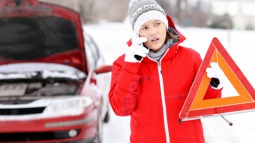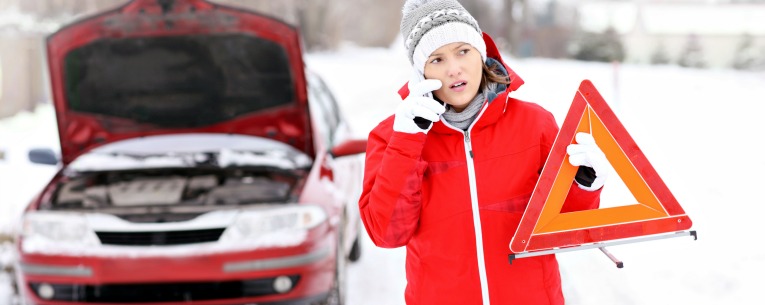Don’t let the first time you think about assembling a winter emergency car kit be while you’re stranded in a snow-covered ditch somewhere outside Altoona, PA.
No, the right time to think about gathering up supplies to dig out of a tough spot or simply wait for AAA safely and comfortably is right about now. So, consider this an interactive article. As we rattle off the all the important items you should consider packing in your winter emergency car kit, simply gather them up. And keep a list to note all the things you still need to pick up afterward.
Putting together a winter emergency car kit – or buying one that comes pre-loaded with all the tools you’ll need – is easier than putting on a set of snow tires. Much easier.
Here we go…
Emergency Car Kit Basic Supplies
Winter, spring, summer or fall, there are some critical supplies you’ll want to pack in your emergency car kit to help you in a pinch or an emergency or a pinch. These include:
1. Water and Food
This is pretty self-explanatory, but just make sure that the food is non-perishable. High-protein snacks such as raisins and trial mix are recommended. For the water, multiple small containers trump one big, heaping container. There are many reasons, from hygiene to being able to melt snow or ice into drinking water with greater ease.1
2. Travel Insurance
Here’s a must-have that won’t take up any extra space in your backseat: travel insurance plans. When it comes to handling emergencies, consider a solid travel insurance plan to be as versatile as a Swiss Army Knife. For starters, it can save you money, for example, providing reimbursement for pre-paid, nonrefundable costs in the event of trip cancellation for a covered reason. And with 24-hour Assistance services, that wait on the shoulder of a Pennsylvania highway just got a little less lonely. Our travel experts are here to help you find your way out of any pickle, whether you need a tow out of that ditch or lodging to escape white-out conditions.
Not only can we guide you to the right travel insurance plan for your trip and budget, but we can also hook you up with rental car insurance. That’s right, many travelers elect to tackle the open road with a rental vehicle —leaving their personal auto insurance out of the equation. Perhaps their rear-wheel drive convertible doesn’t handle icy roads well. Or maybe they don’t want to squeeze the extended family into their cozy sub-compact. Whatever the reason, our OneTrip Rental Car Protector takes the guesswork out of rental car insurance — you know, that awkward moment when you’re standing at the rental counter hemming and hawing about what add-ons to purchase. Instead, OneTrip Rental Car Protector provides a Collision Waiver Damage up to $75,000 and other benefits for as low as $13 per day.2
Here’s one more pro tip: to get even more out of your travel insurance plan, download the Allyz® app. This savvy digital companion provides easy claim and plan access, delivers timely travel alerts, connects you with local emergency service providers, and performs a host of other handy functions.3
3. Flashlight
And batteries. One tip: put the batteries in backward so that the flashlight doesn’t get accidentally turned on when you didn’t intend for it to, sapping all its juice.4
4. Flares and Fluorescent Distress Flag
To signal to passing drivers if you’re broken down on the shoulder – or anywhere else. Cars can be tough to spot at night especially against the backdrop of snow.
5. Booster Cables
Otherwise known as jumper cables, this critical device for providing a spark to your ailing battery – or playing the role of Good Samaritan for someone else – belongs in every car. Today, some car battery charging devices can even transmit power from your car’s lighter or outlet. That said, the good old fashioned rubber and metal-pronged cables still work fine. (Just remember: connect one red cable to dead car’s positive terminal, the other red cable to the booster car’s positive terminal, one black cable to the booster car’s negative terminal, and the other black cable to a piece of bare, fixed metal on the dead car. Perform the steps in that order.)5
6. First Aid Kit
To provide temporary relief of any injuries sustained until medical personnel can arrive. Sometimes, simply the Tylenol are enough to help with the headaches of winter travel.
7. Smart Phone Power Bank
It doesn’t matter if you have a traditional phone charger — if your battery dies, it’s as useless as your defroster when you’re driving across the equator. Pick up a battery power bank anywhere from Amazon to a gas station as an independent, reliable power source.
8. Air Pump
A can of tire inflator and sealant such as Fix-a-Flat can help patch small holes and tears in a pinch, but your tire will be permanently compromised after the fact. Sometimes, you just need to pump up your tires, especially after extreme changes in temperature (The first frost often greets us with the first emergency tire light on our dashboard, right?) Rechargeable, digital air pumps can get the job done (and fit in your glove compartment).
9. Wiper Fluid and Coolant
We’ve all been there: driving on a slushy or icy day when our wiper fluid is bone dry. Next thing you know, you’re reaching outside the window to dump your morning cold brew on the dirty windshield. Don’t waste good coffee; instead, keep an extra gallon of wiper fluid in your car. And while you’re at it, grab some coolant to come along for the ride, too.
Winter Weather Supplies For Your Emergency Car Kit
When the temperature dips below 33F, snow and ice become a factor. And they can affect everything from your visibility and road traction to whether or not your engine will start up when you turn the key. There are a number of scenarios in which wintry conditions can strand and stall you, whether you’re simply stuck in the mall parking lot or ran off the road into a ditch on a little-used country road. When an emergency car kit packed with all the right tools, you can brave the elements knowing that even if you do sputter or spin into some trouble, you’ll have everything you need to either get back on the road or safely wait until help arrives. Here are some of the items you’ll want to be sure to pack before that first frost:
- Scraper and Brush
Expired credit cards make lousy ice scrapers. But a legit ice scraper is the first line of defense when fending of Old Man Winter. Let the car do some of the work by warming it up before attempting to break through the ice block consuming your vehicle. Also, be sure to brush all the snow and ice from the top of your car, which can create visibility challenges and even act as a projectile for trailing cars after loosening up on the open roads. - Shovel
If you skid off the road, the first step you’ll want to take is removing the snow around your tires and creating a path for your wheels to gain some traction. - Road Salt
Liberally apply salt where you’re looking to create a path to get your car unstuck from snow and ice. Also, sprinkle some on your front steps and driveway to prevent taking a spill when you’re headed out to your car in the morning. (Sand or cat litter can also get the job done.) - Tow Rope or Chain
It’s not just for helping you out of ditches or embankments. It’s also for allowing you to help your fellow motorists. - Blankets
Consider a hat, gloves and a jacket, too, if you don’t regularly wear them when you’re out and about. Using the car’s heater while waiting for help is OK; running it for 10 minutes every hour is suggested. Just be sure that your tailpipe is not stuck in snow, otherwise carbon monoxide can seep back into the vehicle. Keep a window cracked just to be safe.4 - Bag of Sand
Keep it in the trunk to aid with traction and stability, especially if you have a rear-wheel drive car. Other heavy items can also get the job done if they’re equally distributed inside the trunk.
One More Tip: Keep your emergency car kit in the backseat if you don’t have access to it from the interior of your car. Trunks can freeze close easily, and the only thing worse than being stuck in a ditch during a snowstorm is being taunted by supplies that are just out of reach4.
So, how’s your kit coming along? Most of these items can easily be found at Wal-Mart, Target, and Amazon. You can also take the approach of buying a pre-made kit, which range in price from less than $25 to more than $150. Just compare the contents to the items on these lists and order any missing pieces a la carte.
In about an hour or less, you can have all the items you’ll need to keep you safe, sound and warm – and expedite your roadside rescue – if you find yourself in Old Man Winter’s crosshairs. The last place you want to be making this emergency car kit checklist is on the side of the road in a ditch with your blinkers on, when it’s 3F and after dusk. Happy trails and safe travels!
Related Articles








Share this Page